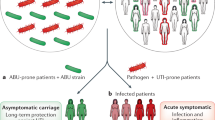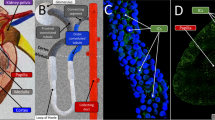Summary
Tamm–Horsfall protein (THP) is exclusively produced by renal tubular cells of the distal loop of Henle and is the most abundant urinary protein in mammals. The physiological function of THP has remained elusive for over half a century; however, new lines of research position it as a central antimicrobial molecule combating urinary tract infection (UTI). Furthermore, the genetic basis of familial juvenile hyperuricemic nephropathy (FJHN), glomerulocystic kidney disease (GCKD) and autosomal dominant medullary cystic kidney disease 2 (MCKD2) has been recently attributed to mutations within the THP gene. In these clinical conditions misfolded THP accumulates in the tubular cells, ultimately leading to overt renal insufficiency. UTI is the most common nonepidemic bacterial infection in humans, where both innate and adaptive components of the immune system as well as the bladder epithelium are involved in its prevention and clearance. Since the urogenital tract is devoid of typical physical barriers such as mucus or a ciliated epithelium, soluble mediators with potent antibacterial capabilities might exist. Recently, genetic ablation of the THP gene was shown to lead to severe infection and lethal pyelonephritis in experimental models of UTI. In addition, mounting evidence indicates that, beyond simply a direct antimicrobial activity, THP is a potent immunoregulatory molecule that induces specific THP-directed cell-mediated immunity. In light of these novel findings the particular role of THP as a specialized defense molecule in the urinary tract is discussed.
Zusammenfassung
Tamm–Horsfall-Protein (THP) wird exklusiv von den tubulären Zellen der distalen Henle’schen Schleife der Niere produziert und ist das am häufigsten vorkommende Protein im Säugetierharn. Die physiologische Funktion von THP war für über ein halbes Jahrhundert unklar, neue Arbeiten weisen jetzt darauf hin, dass THP als zentrales antimikrobielles Molekül bei der Abwehr von Harnwegsinfektionen fungiert. Außerdem konnte gezeigt werden, dass die familiär juvenile hyperurikämische Nephropathie, die glomerulozystische Nierenerkrankung und die autosomal dominante medulläre Zystennierenerkrankung-2 durch Mutationen im THP-Gen ausgelöst werden. Man glaubt, dass bei diesen Erkrankungen dreidimensional nicht richtig gefaltetes THP in den tubulären Zellen akkumuliert und schließlich zu Niereninsuffizienz durch Verstopfung der Tubuli führt. Harnwegsinfektionen sind die häufigsten nichtepidemischen bakteriellen Infektionen beim Menschen, bei denen sowohl Zellen des angeborenen und des erworbenen Immunsystems als auch des Blasenepithels in der Prävention und Abwehr beteiligt sind. Da der Urogenitaltrakt über keine typischen physikalischen Barrieren wie eine Schleimschicht (Mukus) oder behaarte Epithelzellen verfügt, wurde eine Beteiligung löslicher Moleküle, welche potente antibakterielle Eigenschaften besitzen, postuliert. Ein möglicher Kandidat mit direkter antimikrobieller als auch immunzell-aktivierender Aktivität ist das evolutionär konservierte THP. Neuere Ergebnisse zeigen neben einer antimikrobiellen Wirkung auch eine potente immunregulatorische Eigenschaft, welche sogar eine THP-spezifische zell-mediierte Immunität vermittelt. Außerdem wurde nachgewiesen, dass durch genetische Inaktivierung des THP-Gens in Tiermodellen diese Mäuse extrem anfällig für Harnwegsinfektionen und eine lethale Pyelonephritis sind. Im Lichte dieser jüngsten Entwicklungen wird hier im Besonderen die spezielle Rolle von THP als spezifischer Abwehrfaktor bei Harnwegsinfektionen diskutiert.
Similar content being viewed by others
Author information
Authors and Affiliations
Corresponding author
Rights and permissions
About this article
Cite this article
Weichhart, T., Zlabinger, G.J. & Säemann, M.D. The multiple functions of Tamm–Horsfall protein in human health and disease: A mystery clears up. Wien Klin Wochenschr 117, 316–322 (2005). https://doi.org/10.1007/s00508-005-0353-8
Received:
Accepted:
Published:
Issue Date:
DOI: https://doi.org/10.1007/s00508-005-0353-8




